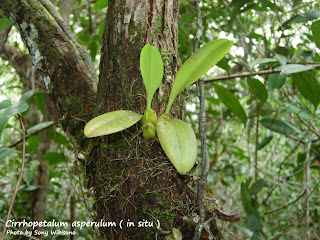 |
| Bulbophyllum Lyriforme |
Section: Stenochilus
Synonyms: -
References say this orchid is found in Papua New Guinea. But i found it in Borneo.
That's why i am not so sure if this is B. lyriforme. But tracing the physical form and the flowers, it is very close to the characteristics of B. lyriforme.
I found in Borneo, in the lowland forest at elevation from 14 to 18 meters, as a tree climbing epiphyte in a circular. Really liked the mossy trees.
The plant is very similiar with B. macranthum and sometimes also similiar with B. patens, except at the tip of the leaf of B. patens is more more obtuse than B. lyriforme.
Has hairy rhizome with well spaced, ovate-elliptic psedobulbs, carrying a single, dark green, oblong, and slightly tapered at the ends.
Flowers: Single, strong fragrant, are always in a state does not open properly.
Dorsal sepal has 6,5 mm width and 3 cm long extend to the front,
Petals has 3 mm width and 3 cm long extend to the side move to the front,
Lateral sepals 3 cm long extend to the front.
Dorsal sepal and petals has a white base color with some dark red to purple spots. But in lateral sepals has yellow/orange and white, this color difference is very contrast, it can be seen that the half part to bottom is yellow and and the remaining half is white.
As well as B. macranthum, by the local people in Central Kalimantan also called "Gaharu" orchid (gaharu means agarwood/eaglewood). They said its strong fragrant smells like aromatic resin.
Bahasa Indonesia:
Referensi lain menyebutkan anggrek ini ditemukan di Papua New Guinea. Tetapi saya menemukannya di Kalimantan.
Itulah kenapa saya masih belum yakin sekali kalau ini adalah B. lyriforme tersebut. Tetapi merunut wujud fisik dan bunganya, sangat mendekati ciri-ciri B. lyriforme.
Saya temukan di Kalimantan di hutan dataran rendah pada ketinggian 14 hingga 18 meter dari permukaan laut, sebagai epipit merambat pada batang pohon secara spiral. Sangat menyukai pohon-pohon yang berlumut.
Tanamannya sangat mirip dengan B. macranthum dan kadang-kadang juga mirip dengan fisik tanaman dari B. patens, kecuali pada ujung daun B. patens lebih tumpul dari B. lyriforme.
Memiliki umbi akar yang berambut dengan jarak yang tidak berdekatan, umbi semunya berbentuk lonjong bulat telur, terdapat satu daun tunggal berwarna hijau tua, membentang lurus, dan agak runcing pada ujungnya.
Bunga: Tunggal, sangat harum, selalu dalam keadaan mekar tidak sempurna.
Sepal dorselis (makhkota sirip belakang) memiliki lebar 6,5 mm dan panjang 3 cm memanjang ke depan,
Kelopak-kelopaknya memiliki lebar 3 mm dan panjang 3 cm memanjang ke samping lalu ke depan,
Sepal lateris (mahkota rusuk) memiliki panjang 3 cm memanjang ke depan.
Sepal dorselis dan kelopak-kelopaknya memiliki warna dasar putih dengan bercak merah tua hingga ungu. Tetapi pada sepal laterisnya memiliki warna kuning/oranye dan putih. Perbedaan warna ini sangat kontras, itu bisa dilihat bahwa separuh bagian ke bawah berwarna kuning dan separuhnya lagi berwarna putih.
Seperti juga B. macranthum, oleh masyarakat di Kalimantan Tengah disebut sebagai "Anggrek Gaharu", mereka mengatakan bahwa wanginya yang kuat tercium seperti wangi damar.



























